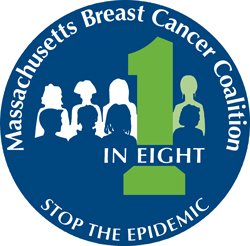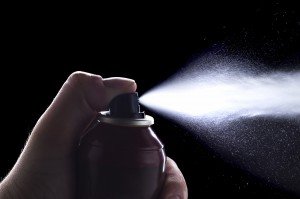 Click here for information and tips to reduce exposure and choose safer alternatives for toxic products.
Click here for information and tips to reduce exposure and choose safer alternatives for toxic products.
Additional research citations are available for some of the chemicals below in the Let’s Talk Prevention booklet for health professionals.
Browse chemicals by name:
1,3-Butadiene

1,3-Butadiene is found in gasoline, car exhaust and cigarette smoke. It is also used in the production of synthetic rubber and plastics. Humans are exposed primarily through inhalation (especially ambient air in areas of high traffic).
The International Agency for Research on Carcinogens lists 1,3-Butadiene as probably carcinogenic to human, and the Institute of Medicine report, “Breast Cancer and the Environment: A Life Course Approach,” notes that out of all the chemicals reviewed, 1,3-Butadiene is one of three chemicals with the strongest evidence for backing attempts to reduce exposure. 1,3-Butadiene is also listed by the National Toxicology Program as a known human carcinogen in the 12th Report on Carcinogens. The U.S. Environmental Protection Agency has not classified 1,3-Butadiene but the weight of the evidence narrative characterizes it as carcinogenic to humans by inhalation.
Reducing Exposure to 1,3-Butadiene
- Avoid high traffic areas during rush hour
- Never smoke or allow smoking inside your home
- Limit the amount of time spent at or around gas stations
- To help reduce the burden of air pollution, minimize car use as much as possible and turn your car off instead of idling (especially when dropping off or picking up children from school)
More Information:
Agency for Toxic Substances and Disease Registry. ToxFAQs for 1,3-butadiene. 2009.
Silent Spring Institute. Mammary Carcinogens Database: 1,3-Butadiene.
1,4-Dioxane

1,4-dioxane is an industrial chemical used in the production of wood office work surfaces, auto products, and adhesives. It is also used as a solvent in plastics, varnishes, and paints, dyes and trace levels have been found in toiletries and cosmetics, including children’s bath products. Human exposure occurs through contact with products containing 1,4-dioxane and from ingesting food that has been treated with pesticides containing 1,4-dioxane.
The International Agency for Research on Carcinogens lists 1,4-dioxane as possibly carcinogenic to humans (sufficient evidence in animals but inadequate human evidence) and the U.S. Environmental Protection Agency lists 1,4-dioxane as probably carcinogenic to humans.
More Information:
Silent Spring Institute. Mammary Carcinogens Database: 1,4-Dioxane.
Alkylphenols
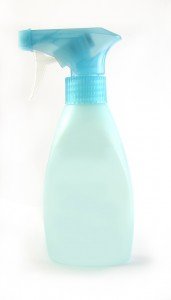 Alkylphenols are a family of highly persistent endocrine-disrupting compounds which have been shown to have estrogenic properties. Nonylphenols, a common subset of alkylphenols, are found in the lining of food containers and wraps, cleaning products, and spermicides. It is likely that humans are exposed to alkylphenols on a daily basis. While the health impacts of alkylphenols are understudied, some existing research suggests that early life exposures are links with altered mammary gland development and potentially increased breast cancer risk.
Alkylphenols are a family of highly persistent endocrine-disrupting compounds which have been shown to have estrogenic properties. Nonylphenols, a common subset of alkylphenols, are found in the lining of food containers and wraps, cleaning products, and spermicides. It is likely that humans are exposed to alkylphenols on a daily basis. While the health impacts of alkylphenols are understudied, some existing research suggests that early life exposures are links with altered mammary gland development and potentially increased breast cancer risk.
The International Agency for Research on Cancer reports that phenols are not classifiable as carcinogenic to humans due to inadequate experimental evidence. Additionally, they are not listed by the U.S. Environmental Protection Agency. However, their potential carcinogenicity is reviewed by both the President’s Cancer Panel and the Interagency Breast Cancer and Environmental Research Coordinating Committee (reports listed below).
More Information:
Aromatic Amines
Aromatic Amines are a family of industrial chemicals used as dyes or in the making of rubber products. The Interagency Breast Cancer and Environmental Research Coordinating Committee states, “experimental evidence indicates that some aromatic amines, such as 4-aminobiphenyl and 4-naphthylamine, are potentially mutagenic and carcinogenic to human breast cells.”
Aryl aromatic amines, a type of aromatic amines, are a component of tobacco smoke and synthetic fuel combustion. Heterocyclic amines, another type of aromatic amine, are formed when meat is cooked and are also a component of tobacco smoke.
More Information:
Atrazine
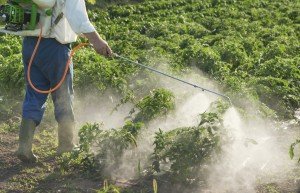
Atrazine, an S-chloro triazine herbicide, was banned from use in the European Union in 2004 but is currently one of the most heavily used herbicides in the U.S. Atrazine contaminants soil, groundwater and drinking water and is an endocrine disrupting compound linked with cancer, birth defects, low sperm count, and problems with reproductive development. Humans are exposed through contaminated air, water, and non-organic produce.
Atrazine is listed by the International Agency for Research on Cancer as not classifiable as a human carcinogen at this time because of inadequate human evidence. While its carcinogenicity is not classified by the U.S. Environmental Protection Agency, atrazine is regulated in drinking water under the Safe Drinking Water Act.
Reducing Exposure to Atrazine
- Purchase fresh, organic produce whenever possible
- Have guests and family members remove shoes upon entering the home to reduce the extent to which pesticides and other chemicals are tracked into the home and trapped inside carpeting
More Information:
Benzene

Benzene is an industrial chemical used in the production of plastics, detergents, pesticides, some rubbers, and some synthetic nylon fibers. It is also released into the air via gasoline (filling stations & car exhaust) and cigarette smoke. Human exposure occurs through inhalation from tobacco smoke, gas stations, & car exhaust as well as ingestion of contaminated water and/or food.
The U.S. Environmental Protection Agency lists benzene as carcinogenic to humans at all routes of exposure. The International Agency for Research on Carcinogens also lists benzene as carcinogenic to humans and the Institute of Medicine report, “Breast Cancer and the Environment: A Life Course Approach,” notes that of all the chemicals reviewed, benzene is one of three chemicals with the most evidence supporting attempts to reduce human exposure. According to the National Toxicology Program, there is clear evidence of carcinogenicity in both mice and rats.
Reducing Exposure to Benzene
- Avoid high traffic areas during rush hour
- Never smoke or allow smoking inside your home
- Limit the amount of time spent at or around gas stations
- To help reduce the burden of air pollution, reduce car use as much as possible and always turn your car off instead of idling (especially when dropping off or picking up children from school)
More Information:
Silent Spring Institute. Mammary Carcinogens Database: Benzene.
Bisphenol A (BPA)
Bisphenol A (BPA) was originally synthesized in the early-mid 1900’s by a chemist seeking a chemical with, especially estrogenic properties. After later synthesizing DES, the chemist abandoned work on BPA. Years later it was discovered that BPA could be used as a component of polycarbonate plastics. Now it is widely used in plastics and other products including children’s toys, water bottles, food containers, food can linings, thermal paper (receipts), and more. Human daily exposure is widespread.
BPA has been classified as a reproductive toxicant in the European Union. The U.S. Food and Drug Administration maintains that current use of BPA is safe. However, widespread daily human exposure has caused some alarm and spurred current debate. Results from urine testing conducted in 2003-2004 by the Centers for Disease Control and Prevention found detectable levels of BPA in 93% of the samples tested. The Interagency Breast Cancer and Environmental Research Coordinating Committee states that following early life exposure, especially during fetal and nursing stages, animal evidence suggests that “BPA induces not only an elevated susceptibility to carcinogens but also the ability to induce spontaneous tumor development” (report citation below).
Reducing Exposure to BPA
- Reduce the amount of time food is stored in the original packaging (reduces exposure to BPA added to that packaging)
- Avoid plastic food and beverage containers which may have BPA in them
- Do not microwave plastics as BPA can leach out into food especially when heated
- Choose fresh produce instead of canned to avoid BPA added to the linings of food cans
- Transfer food and leftovers into airtight glass, stainless steel, or ceramic containers, instead of plastic
More Information:
Dioxins
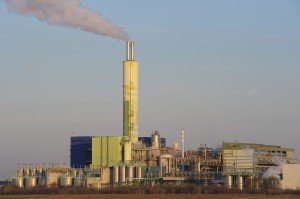
Dioxins are by-products of combustion activities involving the chemical chlorine and carbon-based chemicals like polyvinyl chloride plastics. They are also created during chlorine-bleaching processes and are highly toxic, persistent organic pollutants. Dioxins are endocrine disrupting compounds and existing research links exposure with a variety of health consequences including cancer, developmental and reproductive problems, and immune system damage.
2,3,7,8-Tetrachlorodibenzo-p-dioxin (TCDD), one of the most toxic dioxins, is a component of Agent Orange, an herbicide used as a chemical weapon in the Vietnam War. TCDD has been classified by the International Agency for Research on Cancer as carcinogenic to humans. Typically, other dioxins or dioxin-like chemicals are compared in toxicity and carcinogenicity to TCDD for risk assessment and regulatory purposes.
More Information:
Ethylene Oxide

Ethylene Oxide is a sterilant, disinfectant, and pesticide. It is used to sterilize some consumer products such as foods, clothing, toiletries, cosmetics, medical products/equipment, and more. It is also used in the production of disinfectants, landscaping products, and antifreeze and has been found in tobacco smoke and car exhaust.
The International Agency for Research on Carcinogens lists Ethylene Oxide as carcinogenic to humans and notes sufficient animal evidence but limited human evidence. Ethylene Oxide has been listed by the National Toxicology Program as a known human carcinogen since the 4th Report on Carcinogens was released in 1985. It is also mentioned in the Institute of Medicine report, “Breast Cancer and the Environment: A Life Course Approach,” as one of the three chemicals with the most scientific evidence supporting claims to reduce human exposure.
More Information:
Institute of Medicine. Breast Cancer and the Environment: A Life Course Approach. 2011.
Silent Spring Institute. Mammary Carcinogen Database: Ethylene Oxide.
Flame Retardants

Synthetic flame retardant chemicals are added to a number of consumer products including upholstered furniture and bedding, electronics, and children’s pajamas. These chemicals can leach from products and settle in house dust, sometimes at levels above federal guidelines according to research conducted by Silent Spring Institute. One type which has gained a lot of attention is brominated flame retardants, especially polybrominated diphenyl ethers (PBDEs). These endocrine-disrupting compounds have been linked with cancer and altered reproductive and brain development.
Various different flame retardant chemicals have been banned or phased out of certain uses. However, humans are still exposed on a daily basis due to residues that linger inside homes. Several flame retardants were nominated for in-depth toxicological evaluation in the 12th Report on Carcinogens from the U.S. National Toxicology Program.
Reducing Exposure to Flame Retardants
- Flame retardant chemicals can leach from furniture and settle in house dust so keep dust levels low inside the home by using a vacuum fitting with a HEPA filter and cleaning with a microfiber cloth that traps dust and dirt naturally without the use of chemical additives
- Read labels and look for furniture labeled as “flame retardant free” or “not flame resistant.”
- Look for children’s pajamas with a bright yellow tag that says the garment must be snug fitting as it is not flame resistant.
Formaldehyde
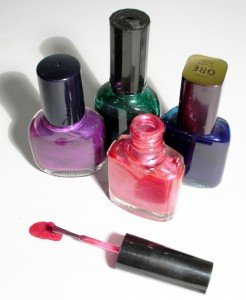
Formaldehyde is an industrial chemical used in the production of resins for molded products like appliances, electric controls, and telephones. It is also in particle-board, plywood, and surface coatings and has been detected as a contaminant in personal care products including children’s and adult’s bath products, nail polish, salon hair styling products, and more.
Formaldehyde was classified as a known human carcinogen in the National Toxicology Program’s 12th Report on Carcinogens. It has also been classified as a known human carcinogen by the International Agency for Research on Cancer and the U.S. Environmental Protection Agency.
More Information:
National Toxicology Program 12th Report on Carcinogens. 2011.
Methylene Chloride

Methylene chloride is an industrial solvent used as a paint stripper and component of some aerosols and pesticides. It is also a component of indoor air pollution due to its use in consumer products including fabric cleaners, furniture polish, auto products, wood finishing products (sealants, stains, varnishes, etc.), paint products (spray paints, paint thinners, strippers, and removers), adhesives and adhesive removers, art supplies, and insecticides.
According to an analysis of Massachusetts industry carcinogen use/release reporting by Toxics Use Reduction Institute, methylene chloride was the third-highest breast carcinogen used and the highest breast carcinogen released by MA industries in 2013. The International Agency for Research on Cancer classifies methylene chloride as possibly carcinogenic to humans with sufficient evidence in animals at multiple tumor sites but inadequate evidence in humans. Similarly, the U.S. Environmental Protection Agency lists methylene chloride as probably carcinogenic to humans and the U.S. National Toxicology Program’s 12th Report on Carcinogens lists it as a reasonably anticipated human carcinogen citing clear evidence of carcinogenicity in mice and rats of both genders.
More Information:
Silent Spring Institute. Mammary Carcinogens Database: Methylene Chloride.
Parabens

Parabens are a family of endocrine-disrupting compounds widely used as preservatives and antimicrobials in food, pharmaceuticals, personal care products, and cosmetics, and adhesives. Concern over paraben exposure results in the chemicals’ mildly estrogenic properties, however, research on health impacts is lacking. Parabens are not currently regulated or classified by the International Agency for Research on Cancer, U.S. National Toxicology Program, or the U.S. Environmental Protection Agency.
Reducing Exposure to Parabens
Paraben exposure can be reduced by checking the labels of personal care products, cosmetics, and over-the-counter medications and/or choosing products labeled “paraben-free.”
More Information:
Perfluorinated Compounds

Perfluorinated compounds are a family of chemicals used in stain-resistant and waterproof coatings in clothing and carpets, fire-fighting foams, electronics, and nonstick coatings such as Teflon for pots and pans. They are endocrine-disrupting compounds and have been linked with altered mammary gland development and changes in puberty. In 2004, the U.S. Centers for Disease Control and Prevention released results of biomonitoring studies showing four different perfluorinated compounds in nearly all study participants.
Perfluorooctanoic acid and other perfluorinated compounds have been nominated as high priority for evaluation by the International Agency for Research on Cancer. Perfluorinated compounds have also been nominated by the U.S. Environmental Protection Agency to the U.S. National Toxicology Program for further study.
Learn more about MBCC’s campaign to remove PFAS from food packaging here.
Reducing Exposure to Perfluorinated Compounds
- Use cast iron or steel clad pots and pans instead of nonstick (like Teflon)
- Try to avoid stain resistant and waterproof coatings on clothing and carpeting.
More Information:
National Institute of Environmental Health Sciences. Perfluorinated Chemicals Fact Sheet.
Environmental Protection Agency. Emerging Contaminants Fact Sheet – PFOS and PFOA. 2012.
Phthalates

Phthalates are endocrine disrupting compounds used to make plastics soft and pliable, especially in the production of polyvinyl chloride (PVC) products (see the section on vinyl chloride, below). They can be found in a variety of consumer products including plastic shower curtains, medical devices and children’s toys (the use of some phthalates has recently been restricted in children’s toys). Phthalates have also been detected in food packaging, toiletries, and cosmetics especially nail polish, hair spray, and any fragranced products. Exposure can occur from inhalation, skin absorption, or ingestion. Research has linked phthalate exposure with altered reproductive development, cancer, birth defects, and infertility especially following in utero or early life exposure.
Phthalates are metabolized quickly inside the body but according to biomonitoring studies conducted by the Centers for Disease Control and Prevention, exposure is widespread. Other studies have detected them in human breast milk. In 2011, the International Agency for Research on Cancer listed di (2-ethylhexyl) phthalate (DEHP) as possibly carcinogenic to humans citing sufficient experimental evidence in animals.
Reducing Exposure to Phthalates
- Reduce the amount of time food is stored in the original packaging (reduces exposure to phthalates added to that packaging)
- Transfer food and leftovers into airtight glass, stainless steel, or ceramic containers, instead of plastic
- Avoid plastic food and beverage containers which may have phthalates in them
- Do not microwave plastics as phthalates can leach out into food especially when heated
- Avoiding the use of commercial air fresheners and other fragranced products can avoid exposure to certain phthalates added to these products
- Opt for cloth shower curtains instead of vinyl as phthalates may leach from the vinyl curtains (and other vinyl products such as pillow protectors)
More Information:
Polychlorinated Biphenyls
Polychlorinated biphenyls, or PCBs, are persistent, dioxin-like compounds. Though most uses of PCBs were banned by the U.S. Environmental Protection Agency in 1979, PCBs can still be released into the environment from landfills or incinerators. Human exposure can also occur from demolition of old buildings in which PCBs were used, specifically in the caulking around doors and windows. During demolition or construction, PCBs can be released from the caulking into the air and travel as dust particles, posing an inhalation risk
PCBs, TDCC (see the section on dioxin, above), and other dioxon-like compounds are reviewed together by the International Agency for Research on Cancer based on their similarities. Classifications range from “carcinogenic to humans” to “limited evidence for carcinogenicity to humans” based on the specific compound. The U.S. National Toxicology Program lists PCBs as reasonably anticipated human carcinogens in the 12th Report on Carcinogens.
More Information:
National Toxicology Program. 12th Report on Carcinogens. 2011.
Polycyclic Aromatic Hydrocarbons (PAH)
 Polycyclic aromatic hydrocarbons (PAHs) are produced as a result of the incomplete combustion of hydrocarbons. Common exposure sources include fireplaces, tobacco smoke, car exhaust, and charred meats. PAH exposure has been linked to cancer, reproductive problems, and impaired immune systems.
Polycyclic aromatic hydrocarbons (PAHs) are produced as a result of the incomplete combustion of hydrocarbons. Common exposure sources include fireplaces, tobacco smoke, car exhaust, and charred meats. PAH exposure has been linked to cancer, reproductive problems, and impaired immune systems.
One common example, benzo[a]pyrene, is classified as carcinogenic to humans by the International Agency for Research on Cancer. The U.S. Environmental Protection Agency classifies benzo[a]pyrene as probably carcinogenic to humans and notes that while animal evidence supports this link, human evidence is lacking. The U.S. National Toxicology Program’s 12th Report on Carcinogens lists 15 different PAHs and classifies them each as reasonably anticipated to be human carcinogens.
Reducing Exposure to PAHs
- When grilling, minimize char by using marinades, reducing the heat level, and avoiding prolonged cooking times
- Try to avoid exposure from air pollution:
- Avoid high traffic areas during rush hour
- Never smoke or allow smoking inside your home
- Reduce the amount of time spent at or around gas stations
- To help reduce the burden of air pollution, try to minimize car use as much as possible and always turn your car off instead of idling (especially when dropping off or picking up children from school)
More Information:
Radiation
Prolonged or frequent exposure to radiation from both natural and medical sources has long been suspected in contributing to negative health outcomes, especially cancer. Radiation can be ionizing or non-ionizing. Based on existing research, the clearest evidence for negative impacts exists for ionizing radiation. Sources of exposure to ionizing radiation include medical scans and equipment, nuclear power generation and accidents, nuclear weapon use, and radon. Specific emphasis is placed on childhood exposure, as radiation exposure is considered to be cumulative over the life course. Exposure has been linked to many forms of cancer.
Radiation exposure from radon, x-rays, and gamma rays is listed by the U.S. National Toxicology Program as known to be a human a carcinogen in the 12th Report on Carcinogens based on sufficient human evidence. The International Agency for Research on Cancer produced an entire monograph devoted to the effects of radiation exposure which concludes that x-radiation (x-rays) is carcinogenic to humans based on sufficient human and animal evidence.
More Information:
National Toxicology Program. 12th Report on Carcinogens. 2011.
Vinyl Chloride

The use of vinyl chloride, in aerosol products was banned in the U.S. in 1974. However, as an industrial chemical, it is still widely used in the production of polyvinyl chloride plastics (PVC). PVC is used for a wide variety of products including medical supplies and equipment, building and construction materials (pipes, flooring, windows etc.), electronic wire insulation, furniture, and more.
Both the U.S. Environmental Protection Agency and International Agency for Research on Cancer classify vinyl chloride as carcinogenic to humans. In the 12th Report on Carcinogens of the National Toxicology Program, vinyl chloride is listed as a reasonably anticipated human carcinogen based on animal evidence.
More Information:
National Toxicology Program 12th Report on Carcinogens: Vinyl Chloride. 2011.
